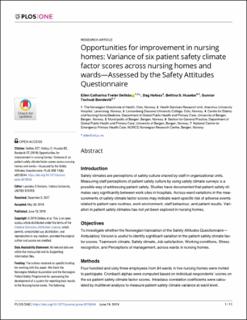| dc.description.abstract | Introduction
Safety climates are perceptions of safety culture shared by staff in organizational units. Measuring staff perceptions of patient safety culture by using safety climate surveys is a possible way of addressing patient safety. Studies have documented that patient safety climates vary significantly between work sites in hospitals. Across-ward variations in the measurements of safety climate factor scores may indicate ward-specific risk of adverse events related to patient care routines, work environment, staff behaviour, and patient results. Variation in patient safety climates has not yet been explored in nursing homes.
Objectives
To investigate whether the Norwegian translation of the Safety Attitudes Questionnaire—Ambulatory Version is useful to identify significant variation in the patient safety climate factor scores: Teamwork climate, Safety climate, Job satisfaction, Working conditions, Stress recognition, and Perceptions of management, across wards in nursing homes.
Methods
Four hundred and sixty three employees from 34 wards in five nursing homes were invited to participate. Cronbach alphas were computed based on individual respondents’ scores on the six patient safety climate factor scores. Intraclass correlation coefficients were calculated by multilevel analysis to measure patient safety climate variance at ward level.
Results
Two hundred and eighty eight (62.2%) returned the questionnaire. At ward level Intraclass correlation coefficients (ICCs) for the factors were 10.2% or higher for the factors Safety climate, Working conditions and Perceptions of management, 2.4% or lower for Teamwork climate, Job satisfaction, and zero for Stress recognition. ICC for variance at nursing home level was zero or less than one per cent for all factor scores.
Conclusions
Staff perceptions of Safety climate, Working conditions and Perceptions of management varied significantly across wards. These factor scores may, therefore, be used to identify wards in nursing homes with high and low risk of adverse events, and guide improvement resources to where they are most needed. | |

